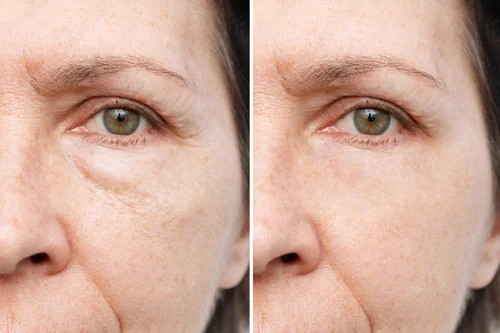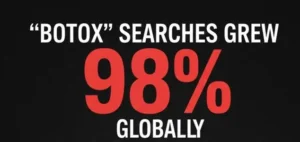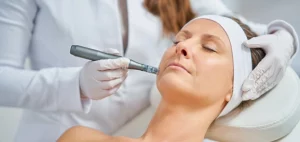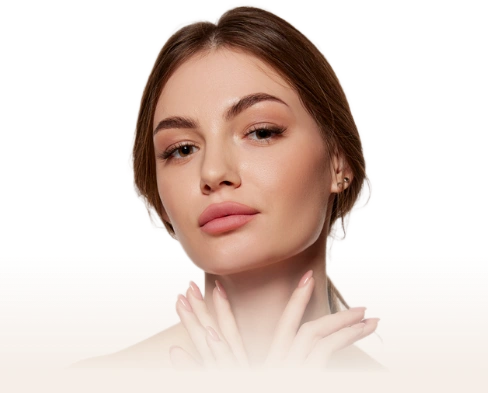In recent years, medical advancements have made it possible to achieve youthful, radiant skin without surgery or invasive procedures. Among these innovations, dermal fillers stand out as a revolutionary solution, offering a safe and effective way to smooth wrinkles, restore lost volume, and enhance natural beauty.
Here in Manhattan, NYC, dermal fillers have become a go-to treatment for those seeking natural-looking results with minimal downtime perfect for the busy lifestyle of New Yorkers. Whether the goal is to refresh tired eyes, plump lips, or contour facial features, fillers deliver subtle yet transformative results.
At the heart of this movement is Dr. Syra Aesthetics, a trusted provider in Manhattan known for expert techniques, personalized care, and treatments focused on achieving results that look as natural as they feel.
What Are Dermal Fillers?
Dermal filler is used to restore volume, smooth wrinkles, and enhance facial contours. According to the American Society of Plastic Surgeons, over 3 million dermal filler procedures were performed in the U.S. in 2023, described as “minimally invasive and effective for facial rejuvenation.”
The benefit of dermal fillers lies in their ability to provide immediate, natural-looking improvements without surgery. Its main alternative or complement is botulinum toxin (Botox), which primarily reduces muscle activity to treat wrinkles. Aesthetic practitioners use dermal fillers to help patients achieve youthful, balanced facial aesthetics.
Dermal fillers originated in the 1980s, with early use of bovine collagen before newer materials like hyaluronic acid became popular in the 2000s. Types of dermal fillers include temporary (hyaluronic acid-based), semi-permanent (calcium hydroxylapatite), and permanent fillers.
What are the types of Dermal Fillers?
Dermal fillers come in various formulations to address different concerns:
- Hyaluronic Acid Fillers
- Calcium Hydroxylapatite (CaHA) Fillers
- Poly-L-lactic Acid (PLLA) Fillers
- Autologous Fillers
- Polymethylmethacrylate (PMMA) Fillers
1. Hyaluronic Acid (HA) Fillers
Hyaluronic acid fillers are among the most popular and widely used dermal fillers. They consist of a gel-like substance that mimics a naturally occurring sugar in the body called hyaluronic acid, which helps retain moisture and add volume to the skin. These fillers are commonly used to smooth out wrinkles, enhance lips, contour cheeks, and restore volume lost due to aging. The longevity of HA fillers typically ranges from 6 to 18 months, depending on the specific product and treatment area.
Examples include Juvederm, Restylane, and Belotero. Because HA is naturally found in the body, these fillers are generally well-tolerated, and their effects are reversible with an enzyme called hyaluronidase if necessary.
Related Read: For a deeper dive into lip fillers, check out the comparison between Restylane and Juvederm to see which might suit your goals best. This guide helps you understand their differences in texture, longevity, and results for lip enhancement.
2. Calcium Hydroxylapatite (CaHA) Fillers
Calcium hydroxylapatite fillers are made from tiny calcium-based microspheres suspended in a gel carrier. CaHA filler stimulates the body’s own collagen production, providing both immediate volume and longer-term skin rejuvenation.
CaHA fillers are especially effective for deeper wrinkles and facial contouring, such as jawline and cheek enhancement. Their effects typically last around 12 to 18 months, sometimes longer due to collagen stimulation. Radiesse is the most common example of a CaHA filler. Because it’s thicker and denser, CaHA is better suited for deeper injection sites rather than fine lines.
3. Poly-L-lactic Acid (PLLA) Fillers
Poly-L-lactic acid fillers work differently from traditional fillers; rather than just adding volume instantly, they stimulate the skin to produce new collagen over time. This collagen boost gradually restores facial volume and improves skin texture.
PLLA fillers are mainly used to treat facial fat loss (lipoatrophy) and to correct deeper wrinkles and folds. The effects appear gradually over a few months and can last up to 2 years or more.
Sculptra is the leading PLLA filler. Because the process is gradual and long-lasting, multiple treatment sessions are usually needed for optimal results.
4. Polymethylmethacrylate (PMMA) Fillers
PMMA fillers contain tiny, biocompatible microspheres suspended in a collagen gel. Unlike other fillers, PMMA provides a semi-permanent solution by physically filling the area and promoting some collagen production.
They are mainly used for deeper wrinkles, folds, and certain types of scars. The longevity of PMMA fillers can extend to 5 years or more, making them one of the longest-lasting options available.
Bellafill is a well-known PMMA filler. Due to their semi-permanent nature, PMMA fillers require careful consideration before use, as removal is difficult.
5. Autologous Fat Injections (Fat Grafting)
While not a synthetic filler, autologous fat injections involve harvesting fat from one part of the patient’s body and injecting it into areas that need volume, such as cheeks, lips, or hands. This method provides a natural filler that can last several years, potentially permanently if the fat survives the transfer.
Fat grafting is used for facial rejuvenation, scar treatment, and contouring. Because it uses the patient’s own tissue, it carries minimal risk of allergic reactions. However, the procedure is more invasive and requires a minor surgical step to harvest fat.
Each type offers specific benefits, and the choice depends on individual needs and goals.
What areas can be treated with dermal fillers?
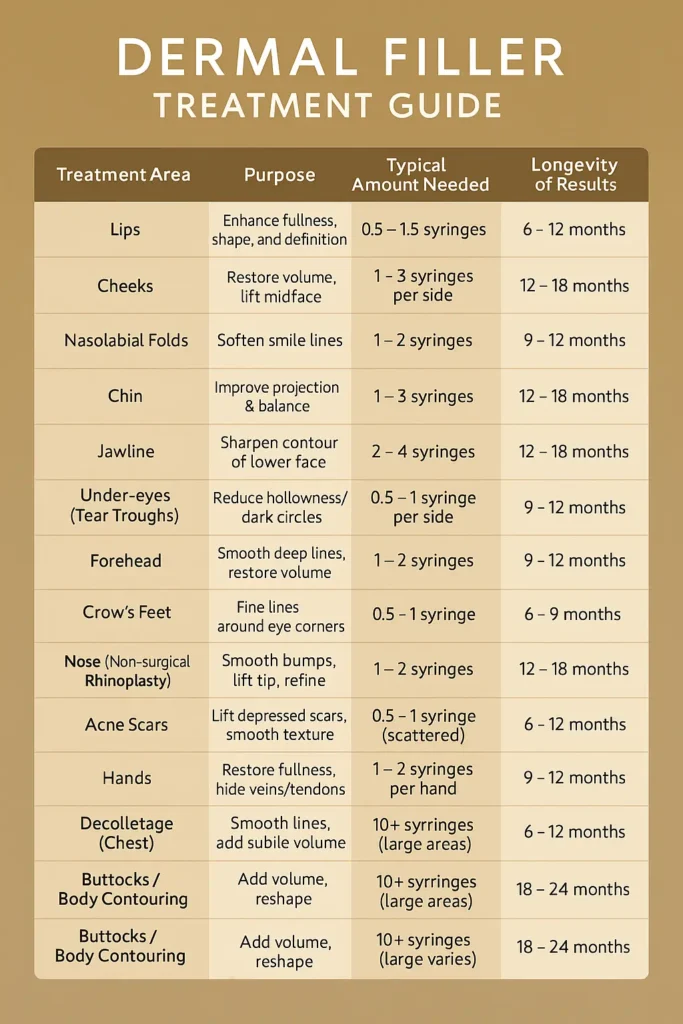
What Are Dermal Fillers Used For?
Dermal fillers are injected beneath the skin, typically into the dermis or the layer just under it called the subcutaneous tissue. The exact injection depth depends on the treatment area and desired effect, ranging from shallow (close to the skin surface) to deeper layers for better volume and contour.
Dermal fillers can be used to treat a wide range of areas on the face and even some parts of the body where volume loss, wrinkles, or contour irregularities occur.
Curious if dermal fillers are right for you? Whether you’re targeting volume loss, fine lines, contouring, or rejuvenation, our 60-second planner helps match your concerns with the right filler type cheek, chin, lips, or under-eye—and gives you personalized guidance to take the next step confidently.
What is the procedure of dermal fillers?
Before the Procedure
Prior to getting dermal fillers, a consultation with a qualified practitioner is essential. During this, your medical history, aesthetic goals, and any allergies or medications are discussed. The practitioner will assess your face or target areas to recommend the best filler type and treatment plan.
You’ll be advised to avoid blood-thinning medications (like aspirin, ibuprofen, or certain supplements) and alcohol for about a week beforehand to reduce the risk of bruising or bleeding. It’s also a good idea to avoid intense sun exposure or skin treatments right before the procedure. Some practitioners may apply a topical numbing cream or offer local anesthesia to make the process more comfortable.
During the Procedure
On the treatment day, the area to be injected is cleaned thoroughly to prevent infection. The practitioner may mark the skin to guide precise placement of the filler. Using a fine needle or cannula, the filler is injected carefully into specific layers beneath the skin, depending on the target area and desired result.
The injections are usually quick, lasting anywhere from 15 to 60 minutes depending on the number of areas treated. You might feel mild discomfort or a slight pinch, but numbing agents often minimize this. After injection, the practitioner may gently massage or mold the filler to ensure even distribution and natural contour.
After the Procedure
Post-treatment, you might experience some redness, swelling, bruising, or tenderness around the injection sites. These are normal and typically resolve within a few days. To reduce swelling and bruising, applying cold compresses is recommended.
You should avoid strenuous exercise, excessive heat (like saunas or sunbathing), alcohol, and blood-thinning medications for at least 24-48 hours after the procedure. It’s best to keep your head elevated while sleeping the first night and avoid touching or massaging the treated areas unless instructed. Follow-up appointments may be scheduled to check results and perform any necessary touch-ups. Most people can resume normal activities immediately after, with minimal downtime.
Dermal Fillers Before And After
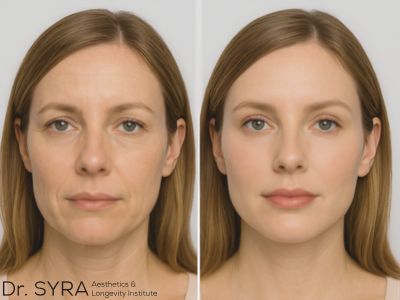
Dermal Fillers Before And After Cheeks

Dermal Fillers Before And After Chin
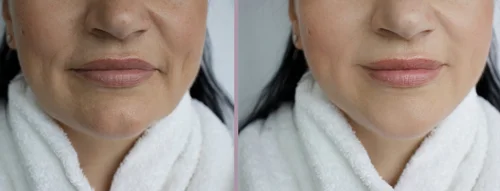
Before And After Fillers Around Mouth

Dermal Fillers Before And After Jawline

Dermal Fillers Before And After Eyes
Dermal Filler Cheeks Before And After

What are the benefits of dermal fillers?
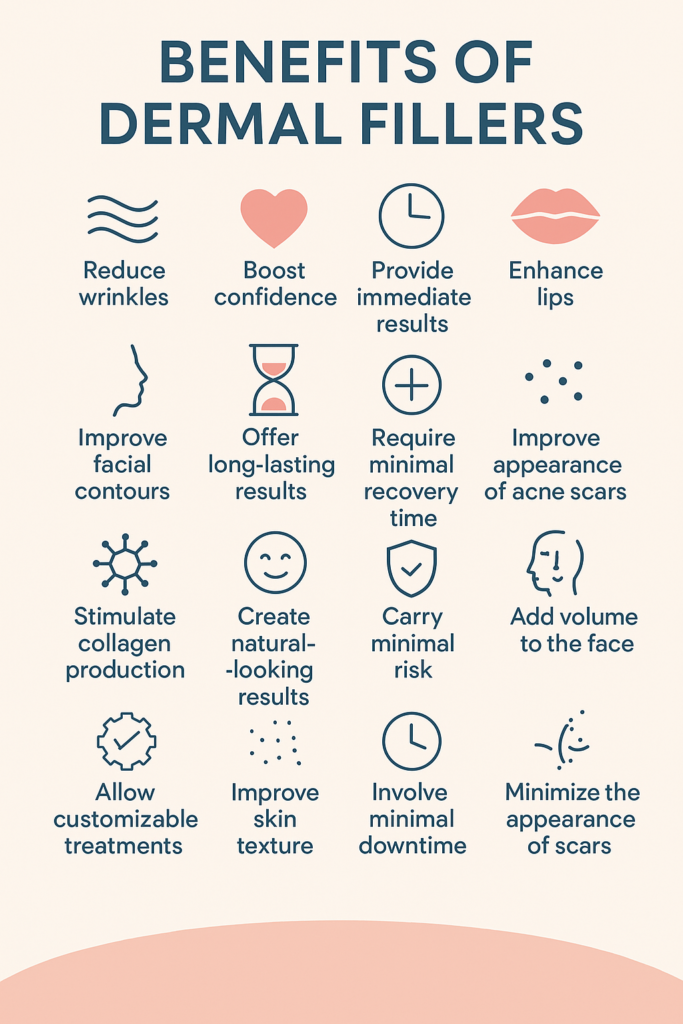
- Reduce wrinkles
- Boost confidence
- Provide immediate results
- Enhance lips
- Improve facial contours
- Offer long-lasting results
- Require minimal recovery time
- Improve the appearance of acne scars
- Stimulate collagen production
- Create natural-looking results
- Carry minimal risk
- Add volume to the face
- Allow customizable treatments
- Improve skin texture
- Involve minimal downtime
- Restore lost facial volume
- Minimize the appearance of scars
How Long Do Dermal Fillers Last?
Dermal fillers last anywhere from 6 months to 2 years, depending on the type of filler, the treatment area, and individual factors like metabolism and lifestyle. The longevity can also be influenced by the injection technique and the amount of movement in the treated area.
How Long Does It Take to Recover from Fillers?
Recovery from fillers generally takes a few days. Most side effects such as swelling, redness, and bruising usually subside within 1 to 7 days, allowing you to return to normal activities quickly. Proper care after treatment helps minimize recovery time and discomfort.
How Long Does it Take to Show Results?
Dermal filler results are typically noticeable right after the treatment, though some mild swelling and redness may be present. Over the next few days, as any initial swelling subsides, the full results become more apparent, revealing a smoother, more youthful complexion.
Am I a candidate for dermal fillers?
A good candidate for dermal fillers is typically a healthy individual who wishes to restore facial volume, smooth out wrinkles, or enhance specific features such as the lips, cheeks, or jawline. The best candidates are those with realistic expectations about the outcome, who do not suffer from autoimmune diseases or bleeding disorders, and who are generally non-smokers or willing to minimize smoking to support healing.
Dermal fillers are not suitable for everyone. People with active skin infections or inflammation at the treatment site should avoid fillers until fully healed. Similarly, individuals who are allergic to filler ingredients, pregnant or breastfeeding, or those with chronic illnesses or compromised immune systems are not considered good candidates. Patients on blood thinners or other medications that interfere with healing should also be cautious, as these may increase the risk of complications.
Dos and Don’ts After Getting Fillers For the First Time
| Dos After Getting Fillers | Don’ts After Getting Fillers |
| Apply ice gently to reduce swelling | Don’t touch or massage the treated area unnecessarily |
| Keep your head elevated, especially while sleeping | Avoid strenuous exercise for 24–48 hours |
| Stay hydrated and maintain a healthy diet | Don’t consume alcohol for at least 24 hours |
| Follow all aftercare instructions from your practitioner | Avoid excessive heat exposure (saunas, hot tubs) for a few days |
| Use gentle skincare products around the treatment area | Don’t get facial treatments like peels or laser for at least 2 weeks |
| Report any unusual pain, swelling, or lumps promptly | Avoid smoking or vaping for a few days |
Pre and Post Care Instructions
| Pre-Care (Before Getting Fillers) | Post-Care (After Getting Fillers) |
| Avoid blood-thinning medications and supplements (like aspirin, ibuprofen, vitamin E, fish oil) for about 1 week before treatment to reduce bruising risk. | Apply ice gently to reduce swelling and soothe the area |
| Avoid alcohol 24–48 hours before treatment | Keep your head elevated, especially while sleeping, for 1–2 days |
| Stay hydrated and maintain healthy skin | Avoid touching or massaging the treated areas unnecessarily |
| Inform your practitioner about any medical conditions or allergies | Avoid strenuous exercise and excessive heat exposure (saunas, hot tubs) for 24–48 hours |
| Avoid skin treatments like chemical peels or laser for at least 2 weeks before | Use gentle skincare products and follow your provider’s instructions |
| Plan for some downtime if needed to manage possible bruising or swelling | Avoid alcohol and smoking for a few days to aid healing |
| Arrive with a clean, makeup-free face | Report any unusual pain, prolonged swelling, or lumps immediately |
Where to get dermal fillers in Manhattan, NYC?
For dermal fillers in Manhattan, NYC, Dr. Syra Aesthetics & Longevity Institute is a top choice. They provide expert, personalized treatments focused on natural results and patient safety. Scheduling a consultation with them ensures a custom plan tailored to your needs, making it one of the best options in the city.
Phone: +1-646-912-8020
Address: 492 6th Avenue New York, NY 10011
How much does dermal filler cost in Manhattan, NYC?
In Manhattan, dermal fillers typically range from $600 to $1,200 per syringe for standard hyaluronic acid fillers like Juvederm or Restylane. Premium fillers or treatments for more delicate areas such as the under-eyes or jawline can cost $1,200 to $2,000+ per syringe, depending on the brand and complexity. On average, most patients in NYC spend $700–$1,300 per syringe for common areas like lips, nasolabial folds, or cheeks, while larger areas such as the cheeks, jawline, or chin may require multiple syringes.
At Dr. Syra Aesthetics, located in the heart of Manhattan, patients receive expert, personalized care with a strong focus on natural results and safety. The consultation itself is free, with only a $50 booking fee required to secure your appointment fully credited toward your treatment. This ensures you get a customized treatment plan tailored to your individual needs without losing any upfront cost.
Pros and cons of dermal fillers
| Pros: | Cons: |
| Provide immediate, noticeable results | Results are temporary and require repeat treatments |
| Non-surgical and minimally invasive | Possible side effects like swelling, bruising, or redness |
| Restore lost volume and smooth wrinkles | Risk of allergic reactions or lumps (rare) |
| Can enhance facial features like lips and cheeks | Cost can add up over time with maintenance |
| Minimal downtime and quick recovery | Not suitable for everyone (e.g., certain health conditions) |
| Effects are often customizable and reversible (for some types) | Incorrect injection technique can cause uneven results or complications |
| Stimulate collagen production with certain fillers |
Which is better, Botox or Filler?
Botox and dermal fillers serve different purposes, so which is better depends on your goals.
Botox works by relaxing muscles to reduce dynamic wrinkles caused by facial movements such as forehead lines, frown lines, and crow’s feet. It’s best for smoothing expression lines and preventing new wrinkles from forming.
Fillers, on the other hand, add volume to areas that have lost fullness due to aging, such as cheeks, lips, and under the eyes. They also smooth out static wrinkles and folds that are visible even when your face is at rest.
If your concern is fine lines from muscle movement, Botox is usually better. If you want to restore volume, contour your face, or fill deeper wrinkles, fillers are the way to go. Many people use both treatments together for a more comprehensive rejuvenation.
Frequently Asked Questions About Dermal Fillers
Are dermal fillers safe for all skin types?
Yes, dermal fillers are generally safe for all skin types when administered by a qualified professional.
What are the Best dermal fillers over 50?
The choice of dermal fillers may vary depending on an individual’s age and specific concerns. Younger individuals may opt for preventative treatments to maintain their youthful appearance, while older individuals may require more comprehensive volume restoration.
Choosing the best dermal fillers for over 50 of age involves addressing unique concerns related to aging skin. As we age, our skin loses elasticity, volume, and moisture, leading to wrinkles, sagging, and a loss of facial contours.
Fortunately, various dermal fillers are well-suited for individuals in this age group. Here are some of the best dermal fillers for over 50 of age:
- Juvederm Voluma
- Restylane Lyft
- Sculptra
- Radiesse
- Belotero
- Volbella
- Sculptra
Can dermal filler cause cancer?
No, there is no evidence that dermal fillers cause cancer.
Are There any Side Effects for Dermal Fillers?
While dermal fillers are generally safe, some individuals may experience mild, temporary side effects. These can include:
- Redness: Temporary redness at the injection site is common and typically subsides within a day or two.
- Swelling: Mild swelling may occur, particularly in the first few days after the procedure.
- Bruising: Some patients may experience bruising at the injection sites, which can be concealed with makeup and usually fades within a week.
- Tenderness: The treated area may be tender to the touch, but this discomfort is usually short-lived.
- Lumps or Bumps: Rarely, small lumps or bumps may form, but they are usually correctable by your provider.
Serious complications are extremely rare when administered by a skilled professional, making dermal fillers a generally low-risk option for facial enhancement. It’s crucial to choose a qualified provider for the procedure to minimize these side effects and ensure a safe and satisfying experience.
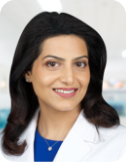
About The Author
Dr. Syra Hanif M.D.
Board Certified Primary Care Physician
Dr. Hanif is the Director of Aesthetic Medicine. She is a board-certified physician in Aesthetic Medicine who specializes in using non-surgical alternatives in order to enhance one's appearance through Botox and fillers.
Read More





